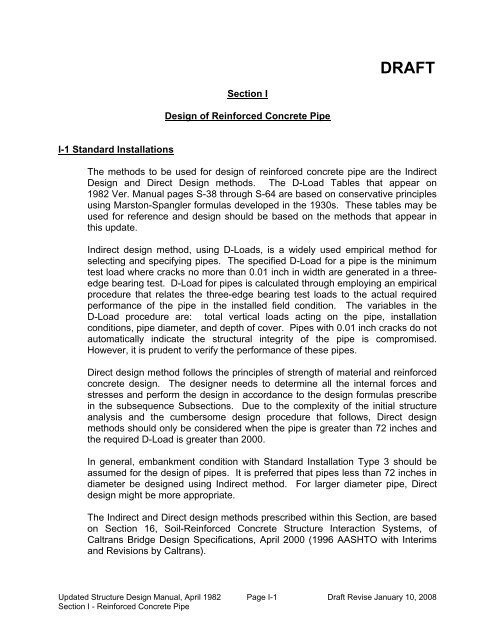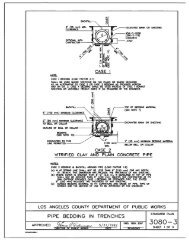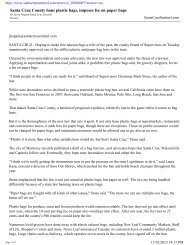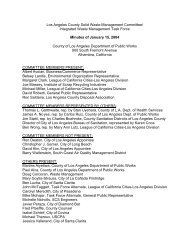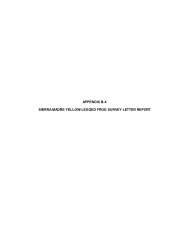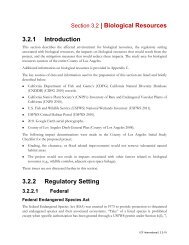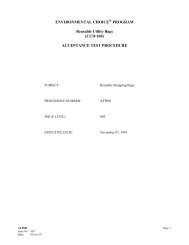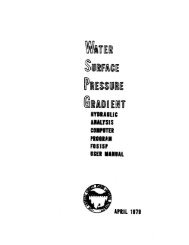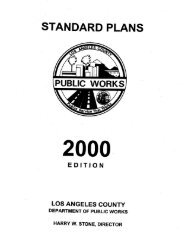Draft - Department of Public Works - Los Angeles County
Draft - Department of Public Works - Los Angeles County
Draft - Department of Public Works - Los Angeles County
Create successful ePaper yourself
Turn your PDF publications into a flip-book with our unique Google optimized e-Paper software.
DRAFT<br />
Section I<br />
Design <strong>of</strong> Reinforced Concrete Pipe<br />
I-1 Standard Installations<br />
The methods to be used for design <strong>of</strong> reinforced concrete pipe are the Indirect<br />
Design and Direct Design methods. The D-Load Tables that appear on<br />
1982 Ver. Manual pages S-38 through S-64 are based on conservative principles<br />
using Marston-Spangler formulas developed in the 1930s. These tables may be<br />
used for reference and design should be based on the methods that appear in<br />
this update.<br />
Indirect design method, using D-Loads, is a widely used empirical method for<br />
selecting and specifying pipes. The specified D-Load for a pipe is the minimum<br />
test load where cracks no more than 0.01 inch in width are generated in a threeedge<br />
bearing test. D-Load for pipes is calculated through employing an empirical<br />
procedure that relates the three-edge bearing test loads to the actual required<br />
performance <strong>of</strong> the pipe in the installed field condition. The variables in the<br />
D-Load procedure are: total vertical loads acting on the pipe, installation<br />
conditions, pipe diameter, and depth <strong>of</strong> cover. Pipes with 0.01 inch cracks do not<br />
automatically indicate the structural integrity <strong>of</strong> the pipe is compromised.<br />
However, it is prudent to verify the performance <strong>of</strong> these pipes.<br />
Direct design method follows the principles <strong>of</strong> strength <strong>of</strong> material and reinforced<br />
concrete design. The designer needs to determine all the internal forces and<br />
stresses and perform the design in accordance to the design formulas prescribe<br />
in the subsequence Subsections. Due to the complexity <strong>of</strong> the initial structure<br />
analysis and the cumbersome design procedure that follows, Direct design<br />
methods should only be considered when the pipe is greater than 72 inches and<br />
the required D-Load is greater than 2000.<br />
In general, embankment condition with Standard Installation Type 3 should be<br />
assumed for the design <strong>of</strong> pipes. It is preferred that pipes less than 72 inches in<br />
diameter be designed using Indirect method. For larger diameter pipe, Direct<br />
design might be more appropriate.<br />
The Indirect and Direct design methods prescribed within this Section, are based<br />
on Section 16, Soil-Reinforced Concrete Structure Interaction Systems, <strong>of</strong><br />
Caltrans Bridge Design Specifications, April 2000 (1996 AASHTO with Interims<br />
and Revisions by Caltrans).<br />
Updated Structure Design Manual, April 1982 Page I-1 <strong>Draft</strong> Revise January 10, 2008<br />
Section I - Reinforced Concrete Pipe
I-2 Design<br />
I-3 Loads<br />
Standard Pipe Installations are presented in <strong>Los</strong> <strong>Angeles</strong> <strong>County</strong> <strong>Department</strong> <strong>of</strong><br />
<strong>Public</strong> <strong>Works</strong>, Standard Plan 3080-3; these figures define soil areas and critical<br />
dimensions. Soil types, minimum compaction requirements, and minimum<br />
bedding thicknesses for Standard Pipe Installation.<br />
Design shall conform to applicable sections <strong>of</strong> this manual except as provided<br />
otherwise in this Section. For design loads, see Subsection I-3; for Standard<br />
Installations, see Subsection I-1. Live loads W L , Fluid weight W f shall be<br />
included as part <strong>of</strong> the total load W T , and shall be distributed through the earth<br />
cover as specified in Subsection I-3.3. Other methods for determining total load<br />
and pressure distribution may be used, if they are based on successful design<br />
practices or tests that reflect the appropriate design conditions.<br />
I-3.1 Earth Loads and Pressure Distribution<br />
I-3.1.1 Earth Loads and Pressure Distribution<br />
The effects <strong>of</strong> soil-structure interaction shall be taken into account and<br />
shall be based on the design earth cover, side fill compaction, and<br />
bedding characteristics <strong>of</strong> the pipe soil installations.<br />
Updated Structure Design Manual, April 1982 Page I-2 <strong>Draft</strong> Revise January 10, 2008<br />
Section I - Reinforced Concrete Pipe
Figure I-1<br />
Table I-1<br />
Installation<br />
Type VAF HAF Al A2 A3 A4 A5 A6 a b c e f u v<br />
1 1.35 0.45 0.62 0.73 1.35 0.19 0.08 0.18 1.40 0.40 0.18 0.08 0.05 0.80 0.80<br />
2 1.40 0.40 0.85 0.55 1.40 0.15 0.08 0.17 1.45 0.40 0.19 0.10 0.05 0.82 0.70<br />
3 1.40 0.37 1.05 0.35 1.40 0.10 0.10 0.17 1.45 0.36 0.20 0.12 0.05 0.85 0.60<br />
Notes:<br />
1. VAF and HAF are vertical and horizontal arching factors. These coefficients<br />
represent nondimensional total vertical and horizontal loads on the pipe, respectively.<br />
The actual total vertical and horizontal loads are (VAF) X (PL) and (HAF) X (PL),<br />
respectively, where PL is the prism load.<br />
2. Coefficients Al through A6 represent the integration <strong>of</strong> nondimensional vertical and<br />
horizontal components <strong>of</strong> soil pressure under the indicated portions <strong>of</strong> the component<br />
pressure diagrams (i.e., the area under the component pressure diagrams). The<br />
pressures are assumed to vary either parabolically or linearly, as shown with the<br />
nondimensional magnitudes at governing points represented by h 1 . h 2 , uh 1 , vh 1 , a,<br />
and b. Nondimensional horizontal and vertical dimensions <strong>of</strong> component pressure<br />
regions are defined by c, d, e, uc, vd, and f coefficients.<br />
3. d is calculated as (0.5 c-e)<br />
h 1 is calculated as (1.5AI)/(c) (I + u)<br />
h 2 is calculated as (1.5A2)/[(d) (1 + v) + (2e)].<br />
Updated Structure Design Manual, April 1982 Page I-3 <strong>Draft</strong> Revise January 10, 2008<br />
Section I - Reinforced Concrete Pipe
I-3.1.2 Standard Installations<br />
For the Standard Installations given in Subsection I-2, the earth load, W E ,<br />
may be determined by multiplying the prism load (weight <strong>of</strong> the column <strong>of</strong><br />
earth) over the pipes outside diameter by the soil-structure interaction<br />
factor, Fe, for the specified installation type.<br />
W E = F e w B c H.<br />
w= unit weight <strong>of</strong> soil, lbs per cubic foot.<br />
B c =<br />
H =<br />
out-to-out horizontal span <strong>of</strong> pipe, or box, foot.<br />
height <strong>of</strong> fill above top <strong>of</strong> pipe, foot.<br />
Standard Installations for both embankments and trenches shall be<br />
designed for positive projection, embankment loading conditions where Fe<br />
=VAF given, in Figure I-1 and Table I-1, for each type <strong>of</strong> Standard<br />
Installation.<br />
For Standard Installations, the earth pressure distribution shall be the<br />
Heger pressure distribution shown in Figure I-1 for each type <strong>of</strong> Standard<br />
Installation.<br />
The unit weight <strong>of</strong> soil used to calculate earth load shall be the estimated<br />
unit weight for the soils specified for the pipe-soil installation and shall not<br />
be less than 110 lbs/cu. ft. (120 lbs/ cu. ft. for pipe designed by the indirect<br />
method).<br />
I-3.1.3 Nonstandard Installations<br />
When nonstandard installations are used, the earth load on the structure<br />
shall be the prism load (PL). The unit weight <strong>of</strong> soil shall be 140 lbs/cu. ft.<br />
Pressure distribution shall be determined by an appropriate soil-structure<br />
interaction analysis. See Figure I-5 for suggested pressure distributions.<br />
I-3.2 Pipe Fluid Weight<br />
The weight <strong>of</strong> fluid, W f in the pipe shall be considered in design based on<br />
a fluid weight <strong>of</strong> 62.4 lbs/ft 3 , unless otherwise specified. For Standard<br />
Installations, the fluid weight shall be supported by vertical earth pressure<br />
that is assumed to have the same distribution over the lower part <strong>of</strong> the<br />
pipe as given in Figure I-1 for earth load.<br />
Updated Structure Design Manual, April 1982 Page I-4 <strong>Draft</strong> Revise January 10, 2008<br />
Section I - Reinforced Concrete Pipe
I-3.3 Live loads<br />
I-3.3.1 Highway Loads<br />
Pipe conduits shall be designed for one HS20-44 truck per lane except<br />
where passing beneath railroad tracks. The wheel loads shall be<br />
distributed through the fill to the top <strong>of</strong> the pipe as follows:<br />
Transverse (with reference to truck) spread <strong>of</strong> wheels = 1.67+1.75F<br />
Longitudinal (with reference to truck) spread <strong>of</strong> wheels = 0.83+1.75F<br />
Where F = depth <strong>of</strong> fill over top <strong>of</strong> conduit in feet.<br />
1. Truck loads on pipe conduits for covers <strong>of</strong> 8 feet and less are as<br />
follows:<br />
TABLE OF VERTICAL LIVE LOADS<br />
Cover "F" Wheel Load L.L. Pressure<br />
Feet Kips PSF<br />
1 16.0 2357 *<br />
2 32.0 967<br />
3 32.0 530<br />
4 32.0 322<br />
5 48.0 245<br />
6 48.0 193<br />
7 48.0 156<br />
8 48.0 129<br />
9 48.0 108<br />
10 48.0 92<br />
These values include the effect <strong>of</strong> overlapping wheel loads and also<br />
the effect <strong>of</strong> impact: 30% for F = 1', 20% for F = 2', and 10% for<br />
F = 3'.<br />
* Wheel loads do not overlap.<br />
2. For covers exceeding 8 feet, the effect <strong>of</strong> truck live loads shall be<br />
assumed to be negligible.<br />
Updated Structure Design Manual, April 1982 Page I-5 <strong>Draft</strong> Revise January 10, 2008<br />
Section I - Reinforced Concrete Pipe
I-3.3.2 Railroad Loading<br />
Conduits passing under railroads shall be designed in accordance with the<br />
requirements <strong>of</strong> the particular railroad. In general, the minimum design<br />
loads are as follows:<br />
Railroad<br />
Cooper Loading<br />
Burlington and Santa Fe E 80<br />
Southern Pacific E 72<br />
Union Pacific E 72<br />
Cooper E 65 loading may be used for industrial spur and connecting<br />
tracks under the jurisdiction <strong>of</strong> Union Pacific Railroad Company.<br />
Values from the chart "Vertical Railroad Loads on Top Slab <strong>of</strong> Box<br />
Conduit" (1982 Ver. Manual page S-10) may be used in determining<br />
vertical railroad loads on pipe.<br />
I-3.4 Other External Loads<br />
Vertical loads due to existing or proposed structures, such as buildings,<br />
abutments, etc., shall be considered in the design.<br />
I-4 Concrete Cover for Reinforcement<br />
The minimum concrete cover for reinforcement in precast concrete pipe shall be<br />
1 inch in pipe having a wall thickness <strong>of</strong> 2 1/2 inches or greater and 3/4 inch in<br />
pipe having a wall thickness <strong>of</strong> less than 2 1/2 inches.<br />
Ordinarily, it is not necessary to call out steel clearances on D-Load pipe.<br />
However, where velocities are between 20 fps and 30 fps, the concrete cover on<br />
the inside face <strong>of</strong> the pipe must be increased 1/2 inch. Where velocities are in<br />
excess <strong>of</strong> 30 fps, the cover on the inside face <strong>of</strong> the pipe must be increased 1<br />
inch. Velocities in excess <strong>of</strong> 40 fps shall not be used without prior District<br />
approval. If the pipe carries debris or abrasive materials, an additional 1/2 inch<br />
<strong>of</strong> concrete cover on the inside is required. If the pipe is subject to the action <strong>of</strong><br />
seawater or harmful groundwater, an additional 1/2 inch <strong>of</strong> cover on the inside or<br />
outside face is required. Pipes subject to harmful industrial wastes may require<br />
additional cover. These increases are accumulative. The amount <strong>of</strong> additional<br />
cover needed and the locations <strong>of</strong> the pipes affected shall be noted in the Special<br />
Provisions Section <strong>of</strong> the detailed specifications.<br />
Updated Structure Design Manual, April 1982 Page I-6 <strong>Draft</strong> Revise January 10, 2008<br />
Section I - Reinforced Concrete Pipe
I-5 Minimum Cover<br />
For unpaved areas and under flexible pavements, the minimum fill cover over<br />
reinforced concrete pipes shall be 2 feet. It is undesirable to install mainline<br />
reinforced concrete pipe where the earth cover or flexible pavement is less than<br />
2 feet. If this is absolutely necessary, the project plans shall provide for concrete<br />
Distribution Slab. This applies to all pipe sizes.<br />
I-6 Design Methods<br />
The structural design requirements <strong>of</strong> installed precast reinforced concrete<br />
circular pipe for both standard and nonstandard installations may be determined<br />
by either the Indirect or Direct Method. Elliptical pipe in nonstandard<br />
installations may be designed by either the indirect or direct method. Elliptical<br />
pipe in standard installations and arch pipe regardless <strong>of</strong> installation type shall<br />
be designed by the indirect method.<br />
I-6.1 Indirect Design Method Based on Pipe Strength and Load-Carrying<br />
Capacity<br />
D 0.01 = ß<br />
⎡WE<br />
+ WF<br />
W ⎤<br />
L 1. 3<br />
⎢ + ⎥<br />
⎢⎣<br />
B fe B fLL ⎥⎦<br />
Si<br />
D 0.01 = D-load <strong>of</strong> the pipe (three-edge-bearing test load expressed in<br />
pounds per linear foot per foot <strong>of</strong> diameter) to produce a<br />
0.01-inch crack.<br />
1. For pipes designed to be under pressure flow condition,<br />
D-load as calculated above shall be modified by<br />
multiplying a hydraulic factor <strong>of</strong> 1.30.<br />
2. For Type 1 installations, D-load as calculated above shall<br />
be modified by multiplying an installation factor <strong>of</strong> 1.10.<br />
ß =<br />
Factor provided by the Technical Review Committee to ensure<br />
cracking will not occur on pipes.<br />
D ult = Ultimate D-load shall be the Ultimate D-load Factor times D 0.01 , see<br />
Figure I-2.<br />
W E = earth load on the pipe as determined according to Subsection I-3.1.<br />
W F =<br />
W L =<br />
B fe =<br />
fluid load in the pipe as determined according to Subsection I-3.2.<br />
live load on the pipe as determined according to Subsection I-3.3.<br />
earth load bedding factor.<br />
Updated Structure Design Manual, April 1982 Page I-7 <strong>Draft</strong> Revise January 10, 2008<br />
Section I - Reinforced Concrete Pipe
B fLL = live load bedding factor.<br />
S i =<br />
internal diameter or horizontal span <strong>of</strong> the pipe in inches.<br />
1.55<br />
1.5<br />
1.45<br />
Ultimate D-Load/Factor<br />
1.4<br />
1.35<br />
1.3<br />
1.25<br />
1.2<br />
0 500 1000 1500 2000 2500 3000 3500 4000 4500<br />
0.01Inch Crack D-Loads<br />
Figure I-2 Ultimate Pipe D-Loads Versus 0.01 Inch Crack D-Loads<br />
D-Loads shall be specified on project drawings as follows:<br />
(Values on Table I-5 have been rounded <strong>of</strong>f to the values listed.)<br />
36-inch diameter and under – to next highest 250 <strong>of</strong> calculated value.<br />
39 - to 60-inch diameter – to next highest 100 <strong>of</strong> calculated value.<br />
63 - to 108-inch diameter – to next highest 50 <strong>of</strong> calculated value.<br />
The minimum D-Load specified shall be 800-D for pipes designed per the Indirect<br />
Design Method. For pipes with an inside diameter <strong>of</strong> 72 inches and larger, the<br />
D-Load from the three-edge-bearing test and its associated internal pipe stresses<br />
may not reflect the actual radial soil pressure experienced by the pipe in the<br />
installed condition. Therefore, for these large diameter pipes, Direct Design<br />
Method may be used in lieu <strong>of</strong> Indirect Design Method.<br />
Updated Structure Design Manual, April 1982 Page I-8 <strong>Draft</strong> Revise January 10, 2008<br />
Section I - Reinforced Concrete Pipe
I-6.1.1 Bedding Factor<br />
The bedding factor is the ratio <strong>of</strong> the supporting strength <strong>of</strong> buried pipe to the<br />
strength <strong>of</strong> the pipe determined in the three-edge-bearing test. The supporting<br />
strength <strong>of</strong> buried pipe depends on the type <strong>of</strong> Standard Installation. See Figures<br />
Standard Plan 3080-3 for circular pipe and Figures I-3 and I-4 for other arch and<br />
elliptical shapes.<br />
1-6.1.1.1 Earth Load Bedding Factor for Circular Pipe<br />
Table I-2 Bedding Factors B ƒe , for Circular Pipe<br />
Standard Installations<br />
Pipe Diameter, Type 1 Type 2 Type 3<br />
12 4.4 3.2 2.5<br />
24 4.2 3.0 2.4<br />
36 4.0 2.9 2.3<br />
72 3.8 2.8 2.2<br />
144 3.6 2.8 2.2<br />
Note:<br />
1. For pipe diameters other than listed, embankment condition bedding<br />
factors B fe can be obtained by interpolation.<br />
2. Bedding factors are based on soils being placed with minimum<br />
compaction specified for each Standard Installation.<br />
Updated Structure Design Manual, April 1982 Page I-9 <strong>Draft</strong> Revise January 10, 2008<br />
Section I - Reinforced Concrete Pipe
Figure I-3 Embankment Beddings, Miscellaneous Shapes<br />
Updated Structure Design Manual, April 1982 Page I-10 <strong>Draft</strong> Revise January 10, 2008<br />
Section I - Reinforced Concrete Pipe
Figure I-4 Trench Beddings, Miscellaneous Shapes<br />
Updated Structure Design Manual, April 1982 Page I-11 <strong>Draft</strong> Revise January 10, 2008<br />
Section I - Reinforced Concrete Pipe
I-6.1.1.2 Earth Load Bedding Factor for Arch and Elliptical Pipe<br />
The bedding factor for installations <strong>of</strong> arch and elliptical pipe, Figures I-5<br />
and I-6, is:<br />
B<br />
fe<br />
C<br />
A<br />
=<br />
C − xq<br />
N<br />
Values for C A and C N are listed in Table I-3.<br />
C A = a constant corresponding to the shape <strong>of</strong> the pipe;<br />
C N = a parameter which is a function <strong>of</strong> the distribution <strong>of</strong> the vertical<br />
load and vertical reaction;<br />
x = a parameter which is a function <strong>of</strong> the area <strong>of</strong> the vertical projection<br />
<strong>of</strong> the pipe over which lateral pressure is effective;<br />
q = ratio <strong>of</strong> the total lateral pressure to the total vertical fill load. Design<br />
values for C A , C N , and x are found in Table I-3. The value <strong>of</strong> q is<br />
determined by the following equations:<br />
Arch and Horizontal Elliptical Pipe:<br />
p ⎛ B<br />
= ⎜ +<br />
c<br />
q 0 .23 1 0.35p<br />
F ⎝ H<br />
e<br />
Vertical Elliptical Pipe:<br />
p ⎛ B<br />
= ⎜ +<br />
c<br />
q 0 .48 1 0.73p<br />
F ⎝ H<br />
e<br />
⎞<br />
⎟<br />
⎠<br />
⎞<br />
⎟<br />
⎠<br />
p =<br />
projection ratio, ration <strong>of</strong> the vertical distance between the outside<br />
top <strong>of</strong> the pipe and the ground or bedding surface to the outside<br />
vertical height <strong>of</strong> the pipe.<br />
Table I-3 Design Values <strong>of</strong> Parameter in Bedding Factor Equation<br />
Values Type <strong>of</strong> Values Projection Values<br />
Pipe <strong>of</strong> C A Bedding <strong>of</strong> C N Ratio <strong>of</strong> x<br />
Horizontal Type 2 0.630 0.9 0.421<br />
Elliptical 1.337 0.7 0.369<br />
And Arch Type 3 0.763 0.5 0.268<br />
0.3 0.148<br />
Type 2 0.516 0.9 0.718<br />
Vertical 0.7 0.639<br />
Elliptical 1.021 Type 3 0.615 0.5 0.457<br />
0.3 0.238<br />
Updated Structure Design Manual, April 1982 Page I-12 <strong>Draft</strong> Revise January 10, 2008<br />
Section I - Reinforced Concrete Pipe
I-6.1.1.3 Live Load Bedding Factor<br />
The bedding factors for live load, W L , for both Circular pipe and Arch and<br />
Elliptical pipe are given in Table I-4. If B ƒe is less than B fLL, use B ƒe instead<br />
<strong>of</strong> B fLL for the live load bedding factor.<br />
Table I-4 Bedding Factors B fLL for HS20 Live Loading<br />
Pipe Diameter, in.<br />
Fill Height, Ft 12 24 36 48 60 72 84 96 108 120 144<br />
0.5 2.2 1.7 1.4 1.3 1.3 1.1 1.1 1.1 1.1 1.1 1.1<br />
1.0 2.2 2.2 1.7 1.5 1.4 1.3 1.3 1.3 1.1 1.1 1.1<br />
1.5 2.2 2.2 2.1 1.8 1.5 1.4 1.4 1.3 1.3 1.3 1.1<br />
2.0 2.2 2.2 2.2 2.0 1.8 1.5 1.5 1.4 1.4 1.3 1.3<br />
2.5 2.2 2.2 2.2 2.2 2.0 1.8 1.7 1.5 1.4 1.4 1.3<br />
3.0 2.2 2.2 2.2 2.2 2.2 2.2 1.8 1.7 1.5 1.5 1.4<br />
3.5 2.2 2.2 2.2 2.2 2.2 2.2 1.9 1.8 1.7 1.5 1.4<br />
4.0 2.2 2.2 2.2 2.2 2.2 2.2 2.1 1.9 1.8 1.7 1.5<br />
4.5 2.2 2.2 2.2 2.2 2.2 2.2 2.2 2.0 1.9 1.8 1.7<br />
5.0 2.2 2.2 2.2 2.2 2.2 2.2 2.2 2.2 2.0 1.9 1.8<br />
5.5 2.2 2.2 2.2 2.2 2.2 2.2 2.2 2.2 2.2 2.0 1.9<br />
6.0 2.2 2.2 2.2 2.2 2.2 2.2 2.2 2.2 2.2 2.1 2.0<br />
6.5 2.2 2.2 2.2 2.2 2.2 2.2 2.2 2.2 2.2 2.2 2.2<br />
I-6.2 Direct Design Method for Precast Reinforced Concrete Circular Pipe<br />
I-6.2.1 General<br />
The direct design method was accepted in 1993 by ASCE and is published in<br />
ASCE 93-15, Standard Practice for Direct Design <strong>of</strong> Buried Precast Concrete<br />
Pipe Using Standard Installation Direct Design (SIDD).<br />
The pressure distribution on the pipe from applied loads and bedding reaction<br />
shall be determined from a soil-structure analysis or shall be a rational<br />
approximation. Acceptable pressure distribution diagrams are the Heger<br />
Pressure Distribution (see Figure I-1) for use with the Standard Installations; the<br />
Olander/Modified Olander Radial Pressure Distribution (see Figure I-5 (a) or the<br />
Paris/Manual Uniform Pressure Distribution (see Figure I-5 (b)).<br />
Updated Structure Design Manual, April 1982 Page I-13 <strong>Draft</strong> Revise January 10, 2008<br />
Section I - Reinforced Concrete Pipe
Figure I-5<br />
Other methods for determining total load and pressure distribution may be used if<br />
based on successful design practice or tests that reflect the appropriate design<br />
condition.<br />
I-6.2.2 Strength-Reduction Factors<br />
Strength-reduction factors for load factor design <strong>of</strong> plant made reinforced<br />
concrete pipe may be taken as 1.0 for flexure (φ f ) and 0.9 for shear (φ v ) and radial<br />
tension (φ r ). For Type 1 installations, the strength-reduction factor shall be 0.9 for<br />
flexure and 0.82 for shear and radial tension.<br />
I-6.2.3 Process and Material Factors<br />
Process and material factors, F rp for radial tension and F vp for shear strength for<br />
load factor design <strong>of</strong> plant made reinforced concrete pipe are conservatively<br />
taken as 1.0. Higher values may be used if substantiated by appropriate test data<br />
approved by the Engineer.<br />
I-6.2.4 Orientation Angle<br />
When quadrant mats, stirrups and/or elliptical cages are used, the pipe<br />
installation requires a specific orientation. Designs shall be based on the<br />
possibility <strong>of</strong> a rotation misorientation during installation by an orientation angle <strong>of</strong><br />
10 degrees in either direction.<br />
Updated Structure Design Manual, April 1982 Page I-14 <strong>Draft</strong> Revise January 10, 2008<br />
Section I - Reinforced Concrete Pipe
I-6.2.5 Reinforcement<br />
I-6.2.5.1 Reinforcement for Flexural<br />
A<br />
s<br />
2<br />
( g( φ d ) − N ( 2 d − h)<br />
− 2M<br />
)<br />
= ⎜⎛<br />
gφ<br />
f<br />
d − NU<br />
− g<br />
f<br />
U<br />
φ<br />
f<br />
⎝<br />
U<br />
⎟⎞<br />
⎠<br />
1<br />
f<br />
y<br />
where g = 0.85 b f' c<br />
b = 12 in.<br />
d= distance from compression face to centroid <strong>of</strong> tension<br />
reinforcement, in.<br />
h= overall thickness <strong>of</strong> member (wall thickness), in.<br />
N u = factored axial thrust acting on cross section <strong>of</strong> width b, lbs/ft.<br />
factored moment acting on cross section <strong>of</strong> width b, in-lbs/ft.<br />
M u=<br />
I-6.2.5.2 Minimum Reinforcement<br />
For inside face <strong>of</strong> pipe:<br />
A<br />
si<br />
b<br />
2 1<br />
= ( Si<br />
+ h)<br />
where b=12 in<br />
12 f<br />
y<br />
For outside face <strong>of</strong> pipe:<br />
A<br />
so<br />
⎛ b ⎞<br />
2 1<br />
= 0.60⎜<br />
⎟( Si<br />
+ h)<br />
where b = 12 in<br />
⎝12<br />
⎠ f<br />
y<br />
For elliptical reinforcement in circular pipe and for pipe with a<br />
33-inch diameter and smaller with a single cage <strong>of</strong> reinforcement in the<br />
middle third <strong>of</strong> the pipe wall, reinforcement shall not be less than A s ,<br />
where:<br />
A<br />
so<br />
⎛ b ⎞<br />
2 1<br />
= 2⎜<br />
⎟( Si<br />
+ h)<br />
where b = 12 in<br />
⎝12<br />
⎠ f<br />
y<br />
where:<br />
h = wall thickness in inches<br />
S i = internal diameter <strong>of</strong> horizontal span <strong>of</strong> pipe in inches.<br />
In no case shall the minimum reinforcement be less than 0.07 square<br />
inches per linear foot.<br />
Updated Structure Design Manual, April 1982 Page I-15 <strong>Draft</strong> Revise January 10, 2008<br />
Section I - Reinforced Concrete Pipe
I-6.2.5.2 Maximum Flexural Reinforcement Without Stirrups<br />
1-6.2.5.2.1 Limited by Radial Tension<br />
A<br />
si max<br />
b ⎛<br />
= ⎜16rs<br />
F<br />
12 ⎜<br />
⎝<br />
rp<br />
f<br />
'<br />
c<br />
⎛ ⎞<br />
⎜<br />
φr<br />
⎟F<br />
⎝φ<br />
f ⎠<br />
rt<br />
1<br />
⎟ ⎟ ⎞<br />
⎠<br />
Fy<br />
A simax =<br />
maximum flexural reinforcement area without<br />
stirrups in 2 /ft where b = 12 in.<br />
F rt = 1+0.00833(72-S i )<br />
For 12 in ≤ S i ≤ 72 in.<br />
F rt =<br />
( 144 − S )<br />
2<br />
i<br />
+ 0.80<br />
26,000<br />
For 72 in. ≤ S i = 144 in.<br />
F rt = 0.8 for S i > 144 in.<br />
F rp = 1.0 unless a higher value substantiated by test<br />
data is approved by the Engineer.<br />
R s = radius <strong>of</strong> the inside reinforcement in inches.<br />
I-6.2.5.2.2 Limited by Concrete Compression<br />
A<br />
si max<br />
4<br />
⎛ ⎡5.5×<br />
10 g'<br />
φ<br />
f<br />
d ⎤<br />
= ⎜<br />
⎢<br />
⎥ − 0.75N<br />
⎜<br />
⎝ ⎢⎣<br />
87,000 + f<br />
y ⎥⎦<br />
U<br />
⎟ ⎟ ⎞<br />
⎠<br />
1<br />
f<br />
y<br />
where:<br />
g ' = bf<br />
'<br />
c<br />
⎛<br />
⎜<br />
0.85 − 0.05<br />
⎝<br />
'<br />
( f − 4,000)<br />
c<br />
1,000<br />
⎞<br />
⎟<br />
⎠<br />
g' =0.85 b f' c and g' min = 0.65 b f' c<br />
I-6.2.5.3 Crack Width Control (Service Load Design)<br />
F<br />
cr<br />
B<br />
=<br />
30,000φ<br />
dA<br />
⎡<br />
⎢M<br />
⎢<br />
⎢<br />
⎢<br />
⎣<br />
⎛ h ⎞<br />
+ N<br />
s ⎜d<br />
− ⎟<br />
⎝ ⎠<br />
− C1bh<br />
ij<br />
s<br />
1 2<br />
f<br />
s<br />
2<br />
f<br />
'<br />
c<br />
⎤<br />
⎥<br />
⎥<br />
⎥<br />
⎥<br />
⎦<br />
Updated Structure Design Manual, April 1982 Page I-16 <strong>Draft</strong> Revise January 10, 2008<br />
Section I - Reinforced Concrete Pipe
Cover for crack control analysis is assumed to be 1 inch over the<br />
tension reinforcement, even if it is greater or less than 1 inch. The<br />
crack control factor F cr in equation above indicates the probability<br />
that a crack <strong>of</strong> a specified maximum width will occur.<br />
When F cr =1.0, the reinforcement area, A s , will produce an average<br />
crack maximum width <strong>of</strong> 0.01 inch. For F cr values less than 1.0, the<br />
probability <strong>of</strong> a 0.01-inch crack is reduced. For F cr values greater<br />
than 1.0, the probability <strong>of</strong> a crack greater than 0.01 inch is<br />
increased.<br />
Where:<br />
F cr<br />
M s<br />
N s<br />
=crack control factor<br />
=bending moment, service load<br />
=thrust (positive when compressive), service load<br />
If the service load thrust, N s , is tensile rather than compressive (this<br />
may occur in pipes subject to intermittent hydrostatic pressure), use<br />
the quantity (1.1 M s – 0.6 N s d) (with tensile N s taken negative) in<br />
place <strong>of</strong> the quantity ([M s +N s (d-h/2)]/ji) in equation above.<br />
J ≅ 0.74+0.1e/d<br />
J max =0.9<br />
1<br />
i =<br />
jd<br />
1−<br />
e<br />
M<br />
s h<br />
e = + d − , in<br />
N<br />
s<br />
2<br />
if e/d
C 1 =Crack Control Coefficient<br />
Type <strong>of</strong> Reinforcement C 1<br />
1. Smooth wire or plain bars 1.0<br />
2. Welded smooth wire fabric, 8 in 1.5<br />
(200mm) maximum spacing <strong>of</strong><br />
longitudinal<br />
3. Welded deformed wire fabric,<br />
1.9<br />
deformed wire, deformed bars, or any<br />
reinforcement with stirrups anchored<br />
thereto<br />
Note: Higher values for C 1 may be used if substantiated by test data<br />
and approved by the Engineer.<br />
I-6.2.5.4 Shear Strength<br />
The area <strong>of</strong> reinforcement, A s , determined in Subsection I-6.2.5.1<br />
or I-6.2.5.3 must be checked for shear strength adequacy, so that<br />
the basic shear strength, V b , is greater than the factored shear<br />
force, V uc , at the critical section located where M nu /V u d=3.0.<br />
where:<br />
⎡<br />
bφvdFvp<br />
f<br />
c<br />
1.1+<br />
63ρ<br />
⎢<br />
⎣<br />
'<br />
Fd<br />
FN<br />
⎤<br />
V b = ( ) ⎥ ⎦<br />
F<br />
V b =shear strength <strong>of</strong> section where M nu /V u d =3.0<br />
F vp =1.0 unless a higher value substantiated by test data<br />
is approved by the Engineer<br />
ρ =A s /bd<br />
ρ max =0.02<br />
’<br />
f c max =7,000 psi<br />
F d =0.8+1.6/d<br />
max F d =1.3 for pipe with two cages, or a single elliptical cage<br />
max F d =1.4 for pipe through 36-inch diameter with a single<br />
circular cage<br />
F c<br />
d<br />
=1 ±<br />
2r<br />
(+) tension on the inside <strong>of</strong> the pipe<br />
(-) tension on the outside <strong>of</strong> the pipe<br />
For compressive thrust (+N u ):<br />
N u<br />
F n =1+<br />
2,000bh<br />
where b=12 in.<br />
e<br />
Updated Structure Design Manual, April 1982 Page I-18 <strong>Draft</strong> Revise January 10, 2008<br />
Section I - Reinforced Concrete Pipe
For tensile thrust (-N u ):<br />
N u<br />
F n =1+<br />
500bh<br />
where b=12 in.<br />
M nu<br />
=M u -N u<br />
If V b is less than V uc , radial stirrups must be provided. See<br />
Subsection I-6.2.5.5.<br />
I-6.2.5.5 Radial Stirrups<br />
I-6.2.5.5.1 Radial Tension Stirrups<br />
( )<br />
1.1s<br />
v<br />
M<br />
u<br />
− 0.45N<br />
uφrd<br />
A vr =<br />
f<br />
vrsφ<br />
rd<br />
where:<br />
A vr =required area <strong>of</strong> stirrup reinforcement for radial<br />
tension<br />
s v =circumferential spacing <strong>of</strong> stirrups<br />
(s v max =0.75φ v d)<br />
f v =maximum allowable strength <strong>of</strong> stirrup material<br />
(f max =f y , or anchorage strength whichever is less)<br />
I-6.2.5.5.2 Shear Stirrups<br />
1.1s<br />
v<br />
A vs = [ V F −V<br />
]<br />
u<br />
c<br />
c<br />
f<br />
vsφrd<br />
where:<br />
A vs =required area <strong>of</strong> stirrups for shear reinforcement<br />
V u =factored shear force as section<br />
4V<br />
b<br />
V c =<br />
M<br />
nu<br />
+ 1<br />
V d<br />
u<br />
'<br />
V c max =2φ<br />
vbd<br />
f c<br />
S v max =0.75f v d<br />
F v max =f y or anchorage strength, whichever is less<br />
A conservative approximation <strong>of</strong> the total required stirrup<br />
area is:<br />
A v =A vs +A vr<br />
Updated Structure Design Manual, April 1982 Page I-19 <strong>Draft</strong> Revise January 10, 2008<br />
Section I - Reinforced Concrete Pipe
I-6.2.5.5.3 Stirrup reinforcement Anchorage<br />
I-6.2.5.5.3.1 Radial Tension Stirrup Anchorage<br />
When stirrups are used to resist radial tension, they shall be<br />
anchored around each circumferential <strong>of</strong> the inside cage to<br />
develop the design strength <strong>of</strong> the stirrup, and they shall also<br />
be anchored around the outside cage, or embedded<br />
sufficiently in the compression side to develop the design<br />
strength <strong>of</strong> the stirrup.<br />
I-6.2.5.5.3.2 Shear Stirrup Anchorage<br />
When stirrups are not required for radial tension but required<br />
for shear, their longitudinal spacing shall be such that they<br />
are anchored around each or every other tension<br />
circumferential. Such spacings shall not exceed 6 inches<br />
(150 mm).<br />
I-6.2.5.5.3.3 Stirrup Embedment<br />
Stirrups intended to resist forces in the invert and crown<br />
regions shall be anchored sufficiently in the opposite side <strong>of</strong><br />
the pipe wall to develop the design strength <strong>of</strong> the stirrup.<br />
I-6.3 Development <strong>of</strong> Quadrant Mat Reinforcement<br />
I-6.3.1 When the quadrant mat reinforcement is used, the area <strong>of</strong> the continuous<br />
main cages shall be no less than 25 percent <strong>of</strong> the area required at the point <strong>of</strong><br />
maximum moment.<br />
I-6.3.2 In lieu <strong>of</strong> I-6.3.1, a more detailed analysis may be made.<br />
I-6.3.2.1 For quadrant mat reinforcement consisting <strong>of</strong> welded smooth wire<br />
fabric, the outermost longitudinals on each end <strong>of</strong> the circumferentials<br />
shall be embedded: (a) past the point where the quadrant reinforcement is<br />
no longer required by the orientation angle plus the greater <strong>of</strong> 12<br />
circumferential wire diameters or percent <strong>of</strong> the wall thickness <strong>of</strong> the pipe,<br />
and (b) past the point <strong>of</strong> maximum flexural stress by the orientation angle<br />
plus the development length, L d .<br />
A<br />
L d = 0.27<br />
s<br />
f<br />
wr y<br />
'<br />
f<br />
c<br />
Updated Structure Design Manual, April 1982 Page I-20 <strong>Draft</strong> Revise January 10, 2008<br />
Section I - Reinforced Concrete Pipe
ut not less than:<br />
L d =s l +1<br />
The mat shall contain no less than two longitudinals at a distance 1-inch<br />
greater than that determined by the orientation angle from either side <strong>of</strong><br />
the point requiring the maximum flexural reinforcement.<br />
The point <strong>of</strong> embedment <strong>of</strong> the outermost longitudinals <strong>of</strong> the mat shall be<br />
at least a distance determined by the orientation angle past the point<br />
where the continuing reinforcement is no less than the double area<br />
required for flexure.<br />
I-6.3.2.2 For quadrant mat reinforcement consisting <strong>of</strong> deformed bars,<br />
deformed wire, or welded wire fabric (a) circumferentials shall extend past<br />
the point where they are no longer required by the orientation angle plus<br />
the greater <strong>of</strong> 12 wire diameters or percent <strong>of</strong> the wall thickness <strong>of</strong> the<br />
pipe. (b) The circumferentials shall extend on either side <strong>of</strong> the point <strong>of</strong><br />
maximum flexural stress not less than the orientation angle plus the development<br />
length L d required by equation below and (c) they shall extend at<br />
least a distance determined by the orientation angle past the point where<br />
the continuing reinforcement is no less than double the area required by<br />
flexure.<br />
0.03d<br />
L d =<br />
A<br />
wa<br />
but not less than:<br />
b<br />
f<br />
A<br />
y wr<br />
'<br />
f<br />
c<br />
L d =0.015 d<br />
b<br />
f<br />
y<br />
f<br />
'<br />
c<br />
I-7 D-Load Tables for Design <strong>of</strong> Reinforced Concrete Pipe<br />
D-Load Tables I-6 to I-8 for Design <strong>of</strong> Reinforced Concrete Pipe, may be used to<br />
determine D-Loads for pipes if the loading conditions shown correspond to those <strong>of</strong><br />
the pipe to be designed. It should be noted that in State Highways: (1) The minimum<br />
D-Load is 1,000.<br />
In calculating D-Loads, the design unit soil weight shall ordinarily be taken as 120 pcf,<br />
except where soil analysis and judgment indicate earth loads should be increased.<br />
Therefore, D-Loads should normally be taken from Table I-7. However, on all<br />
projects, the soil report should be carefully analyzed and the applicable standard<br />
drawing used. Where unusual conditions exist that are not covered by the standard<br />
drawings, calculations must be submitted.<br />
Updated Structure Design Manual, April 1982 Page I-21 <strong>Draft</strong> Revise January 10, 2008<br />
Section I - Reinforced Concrete Pipe
Pipe designs based on the maximum amount <strong>of</strong> earth fill plus live load are not always<br />
the critical loading condition; the minimum amount <strong>of</strong> fill plus live load may be the<br />
control. This occurs most frequently with catch basin connector pipes, especially<br />
connector pipes for catch basins in series.<br />
I-8 Pipe to be Jacked<br />
Refer to Section G2, Section G2-16, Box Conduits to be jacked.<br />
The minimum length <strong>of</strong> the jacking pit is one pipe length plus 10 feet.<br />
The design <strong>of</strong> pipe to be jacked shall be based on superimposed loads and not upon<br />
loads which may be placed upon the pipe as a result <strong>of</strong> jacking operations. Any<br />
increase in pipe strength required in order to withstand jacking loads shall be the<br />
responsibility <strong>of</strong> the Contractor.<br />
In general, the jacking <strong>of</strong> pipe conduits should not be specified where the cover is<br />
less than 6 feet, or under railroads where the cover is less than the greater <strong>of</strong> 6 feet<br />
or 1/2 the outside diameter <strong>of</strong> the conduit.<br />
I-9 Rubber Gasket Joint Pipe<br />
Rubber gasket joint pipe should be used when:<br />
1. The pipe conduit is under substantial pressure head. Amount <strong>of</strong> head is a function<br />
<strong>of</strong> depth <strong>of</strong> cover, type <strong>of</strong> backfill, etc.<br />
2. Pipe conduits, which outlet to pump stations, are placed in sandy soil, and there is<br />
a possibility <strong>of</strong> sand infiltrating into the pipe through the joints.<br />
3. There is a possibility <strong>of</strong> the pipe conduit deflecting due to settlement, as in the<br />
case <strong>of</strong> future freeway fill being placed over the pipe, and installations with varying<br />
cover or varying subgrade conditions. An elastomeric sealant may also be<br />
considered in this case.<br />
It is requested that the District be consulted prior to the start <strong>of</strong> detailed design if the<br />
hydraulic grade line is 10 feet or more above the s<strong>of</strong>fit or finish grade.<br />
Where rubber gasket joint bell and spigot pipe is specified, the pipe shall be<br />
reinforced per the <strong>County</strong> <strong>of</strong> <strong>Los</strong> <strong>Angeles</strong> <strong>Department</strong> <strong>of</strong> <strong>Public</strong> <strong>Works</strong> Standard<br />
Plans 3096-1.<br />
Where pressure pipe is specified the plan shall include, where applicable, a detail for<br />
a pressure joint where pipe is joined to cast-in-place structures, such as manhole<br />
bases, transition structures, etc.<br />
Updated Structure Design Manual, April 1982 Page I-22 <strong>Draft</strong> Revise January 10, 2008<br />
Section I - Reinforced Concrete Pipe
I-10 Pressure Test<br />
A pressure test is required when the pipe conduit is under a substantial head. It is<br />
requested that the District be consulted when the pressure is greater than 1.5 times<br />
the depth <strong>of</strong> cover.<br />
I-11 General Notes<br />
The following note shall appear on all project drawings where concrete pipe is<br />
specified:<br />
Design <strong>of</strong> the pipe shown hereon is based on the assumption the pipe will be<br />
installed in accordance with Type 3 Standard Installation as shown on Standard<br />
Plan 3080-3 unless otherwise shown.<br />
Updated Structure Design Manual, April 1982 Page I-23 <strong>Draft</strong> Revise January 10, 2008<br />
Section I - Reinforced Concrete Pipe
Table I-5<br />
Required D-Load for Reinforced Concrete Pipe Per Standard Installation Type 3<br />
Design Soil Density = 120 pcf<br />
Pipe<br />
Depth <strong>of</strong> cover<br />
Pipe<br />
Size 1 2 3 4 5 6 7 8 9 10 11 12 13 14 15 16 17 18 19 20 21 22 23 24 25 26 27 28 29 30 Size<br />
12 2250 1250 800 800 800 1000 1000 1250 1250 1500 1500 1500 1750 1750 2000 2000 2250 2250 2500 2500 2500 2750 2750 3000 3000 3250 3250 3500 3500 3750 12<br />
15 2000 1250 800 800 800 1000 1000 1250 1250 1500 1500 1500 1750 1750 2000 2000 2250 2250 2250 2500 2500 2750 2750 3000 3000 3250 3250 3500 3500 3500 15<br />
18 2000 1000 800 800 800 1000 1000 1250 1250 1250 1500 1500 1750 1750 2000 2000 2250 2250 2250 2500 2500 2750 2750 3000 3000 3250 3250 3250 3500 3500 18<br />
21 2000 1000 800 800 800 1000 1000 1250 1250 1500 1500 1500 1750 1750 2000 2000 2250 2250 2250 2500 2500 2750 2750 3000 3000 3250 3250 3250 3500 3500 21<br />
24 2000 1000 800 800 1000 1000 1000 1250 1250 1500 1500 1500 1750 1750 2000 2000 2250 2250 2250 2500 2500 2750 2750 3000 3000 3250 3250 3500 3500 3500 24<br />
27 2250 1000 800 800 1000 1000 1000 1250 1250 1500 1500 1500 1750 1750 2000 2000 2250 2250 2500 2500 2500 2750 2750 3000 3000 3250 3250 3500 3500 3500 27<br />
30 2250 1250 800 800 1000 1000 1000 1250 1250 1500 1500 1500 1750 1750 2000 2000 2250 2250 2500 2500 2500 2750 2750 3000 3000 3250 3250 3500 3500 3750 30<br />
33 2500 1250 1000 800 1000 1000 1000 1250 1250 1500 1500 1750 1750 1750 2000 2000 2250 2250 2500 2500 2750 2750 2750 3000 3000 3250 3250 3500 3500 3750 33<br />
36 2500 1250 1000 800 1000 1000 1250 1250 1250 1500 1500 1750 1750 1750 2000 2000 2250 2250 2500 2500 2750 2750 3000 3000 3000 3250 3250 3500 3500 3750 36<br />
42 2200 1100 900 800 900 1000 1100 1200 1300 1400 1500 1600 1700 1800 1900 2000 2200 2300 2400 2500 2600 2700 2800 3000 3100 3200 3300 3400 3500 3600 42<br />
48 2000 1200 900 900 900 1000 1100 1200 1300 1400 1500 1600 1700 1800 1900 2100 2200 2300 2400 2500 2600 2700 2900 3000 3100 3200 3300 3400 3600 3700 48<br />
54 1900 1200 900 900 900 1000 1100 1200 1300 1400 1500 1600 1700 1900 2000 2100 2200 2300 2400 2500 2700 2800 2900 3000 3100 3200 3300 3500 3600 3700 54<br />
60 1800 1300 900 900 1000 1000 1100 1200 1300 1400 1500 1700 1800 1900 2000 2100 2200 2300 2400 2600 2700 2800 2900 3000 3100 3300 3400 3500 3600 3700 60<br />
66 1750 1350 900 900 950 1050 1100 1200 1300 1450 1550 1650 1750 1850 2000 2100 2200 2350 2450 2550 2700 2800 2900 3050 3150 3250 3400 3500 3600 3750 66<br />
72 1700 1450 950 900 950 1050 1150 1250 1350 1450 1550 1650 1800 1900 2000 2150 2250 2350 2450 2600 2700 2850 2950 3050 3200 3300 3400 3550 3650 3750 72<br />
78 1600 1450 1000 900 1000 1050 1150 1250 1350 1450 1550 1700 1800 1900 2000 2150 2250 2350 2500 2600 2700 2850 2950 3050 3200 3300 3400 3550 3650 3750 78<br />
84 1500 1450 1050 950 1000 1050 1150 1250 1350 1450 1600 1700 1800 1900 2050 2150 2250 2400 2500 2600 2750 2850 2950 3100 3200 3300 3450 3550 3650 3800 84<br />
90 1400 1500 1100 1000 1000 1100 1200 1300 1400 1500 1600 1700 1850 1950 2050 2150 2300 2400 2500 2650 2750 2850 3000 3100 3200 3350 3450 3550 3700 3800 90<br />
96 1400 1500 1100 1000 1000 1100 1200 1300 1400 1500 1600 1700 1850 1950 2050 2150 2300 2400 2500 2650 2750 2850 3000 3100 3200 3350 3450 3550 3700 3800 96<br />
102 1450 1500 1150 1000 1050 1100 1200 1300 1400 1500 1600 1750 1850 1950 2050 2200 2300 2400 2550 2650 2750 2900 3000 3100 3250 3350 3450 3600 3700 3800 102<br />
108 1450 1450 1200 1050 1050 1150 1200 1300 1400 1550 1650 1750 1850 1950 2100 2200 2300 2450 2550 2650 2800 2900 3000 3100 3250 3350 3450 3600 3700 3850 108<br />
Data:<br />
Live Load:<br />
H20-S16-44 Truck<br />
LOS ANGELES COUNTY<br />
DEPARTMENT OF PUBLIC WORKS<br />
D-LOAD TABLE I-5 FOR<br />
DESIGN OF REINFORCED<br />
CONCRETE PIPE<br />
DRAFTER DESIGNER CHECKER<br />
SUBMITTED<br />
BY<br />
RECOMMENDED<br />
DATE ASSISTANT DEPUTY DIRECTOR DATE<br />
APPROVED DONALD L. WOLFE, DIRECTOR OF PUBLIC WORKS<br />
BY<br />
BY<br />
DEPUTY DIRECTOR<br />
SCALE DATE DRAWING NUMBER<br />
RL RL S-<br />
DATE


